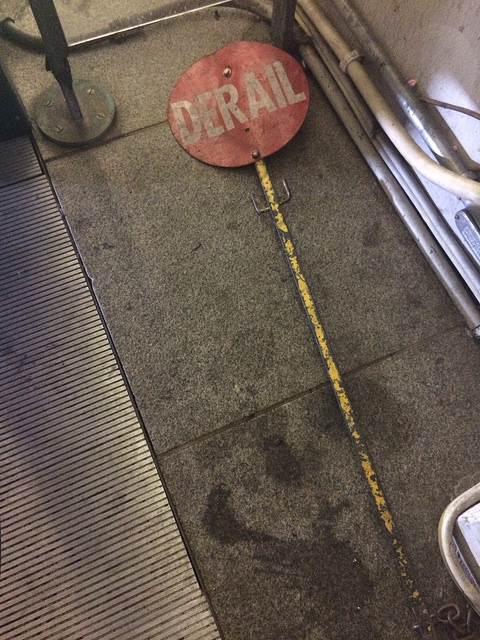
Photo by PoPville flickr user nevermindtheend
From WMATA:
“As part of the Authority’s investigation into the cause of an August 6th derailment, WMATA’s technical incident report to the Interim General Manager was released to the public today. To view report click here. The report will be the subject of a special Board of Directors Safety Committee Meeting on September 3.
“While the safety investigation is continuing and subject to review by the Tri-State Oversight Committee (TOC), the operations report reveals that the physical root cause of the derailment was the failure of fasteners to properly hold the rail securely. This was compounded by a lack of systematic, immediate review of data generated during the inspection vehicle runs,” said Safety Committee Chairman Michael Goldman speaking on behalf of the Board. “The investigation is ongoing to determine what caused those fasteners to fail. Further, the wide gauge track condition that went unrepaired was a contributory factor leading to the derailment that should never have occurred.”
According to the Incident Report, a Metro employee operating the Track Geometry Vehicle (TGV) that identified a “Level Black’ rail defect on July 9th mistakenly deleted the information about the defect from the exception report. That report was given to maintenance crews for scheduling immediate repairs to the rail system. Under the then-established protocols, the employee’s report with erroneously-deleted information was not subject to review by any Metro supervisor. The underlying data was not analyzed by other Metro departments for errors until after the derailment occurred on August 6.
“In reviewing the TGV inspection process, we have learned that the derailment was caused by a combination of human error and flawed Metro processes,” Goldman said. “While the employee believed he was deleting a routinely detected anomaly and not an actual rail defect, that such a serious error went undetected with no checks and balances in place reveals gaps in Metro’s safety policies and procedures.”
Still under investigation by Metro’s Safety Department is why the wide gauge condition and the broken fasteners went undetected by Metro track walkers who inspected this area of track on multiple occasions between the TGV run on July 9 and the August 6 derailment.
The Report also documents the immediate actions Metro has taken since August 6 to assure the safety of its passengers. Those include comprehensive inspections and immediate repairs of defects, the thorough review of the track inspection vehicle’s test results with an area manager prior to the generation of the final report for the maintenance crews, making track walker inspections more robust, and engineering reviews by outside experts.
In order to prevent such track safety failures from occurring in the future, the Board’s Safety Committee will review management’s actions and additional process and policy changes, as well as consider the need for “beefed up” safety reporting and consideration of protocols in other safety-critical areas to ensure maintenance crews have the most reliable information possible in order to schedule critical repairs. Further, the Committee will review how effectively the Authority’s System Safety Plan is meeting the safety culture needs of the organization and will examine if sufficient resources are available to meet the priority infrastructure inspection and maintenance requirements.
Questions and Answers
1. What caused the derailment? Read More
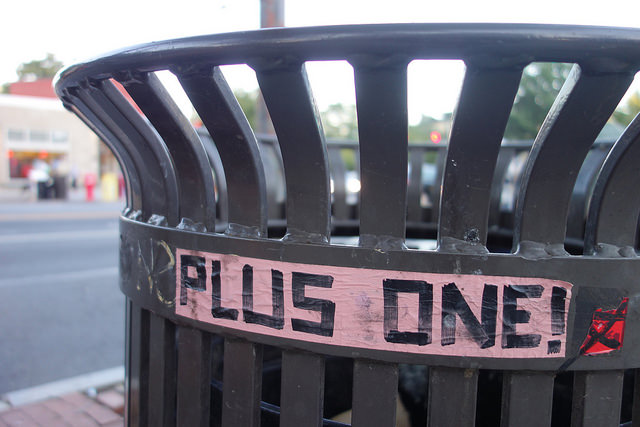
Photo by PoPville flickr user nevermindtheend
“Dear PoPville,
Wondering if you or anyone can shed some light on this: for the past week or two at least, the yellow line trains have been going quite slow over the bridge to and from Virginia. One morning, the conductor announced that the train was “required to go at a restricted speed between L’Enfant Plaza and Pentagon,” but other than that I haven’t seen any announcement or explanation. Does anyone know what’s going on?”
another reader writes:
“Metro has imposed speed restrictions on various portions of its track in response to the recent derailment. The red line train has gotten SUPER SLOW on certain stretches of track during my commute lately, resulting in noticeable delays. It seems reasonable to infer that the same defect that caused the derailment may be rampant throughout the system. Given that metro is subject to zero accountability, I worry that it may just be a matter of time before more people die.”
The Washington Post reported:
“Metro has implemented speed restrictions on curves throughout the system. That means trains are slowing to 35 mph to 40 mph as they approach a curve. The restrictions are in place as part of what Metro calls an “aggressive campaign” to inspect curved sections of track following the Aug. 6 derailment between the Federal Triangle and Smithsonian Metro stations.”
Ed. Note: PoP-Ed. posts are received unsolicited. If you have an issue you’d like to discuss please email [email protected]
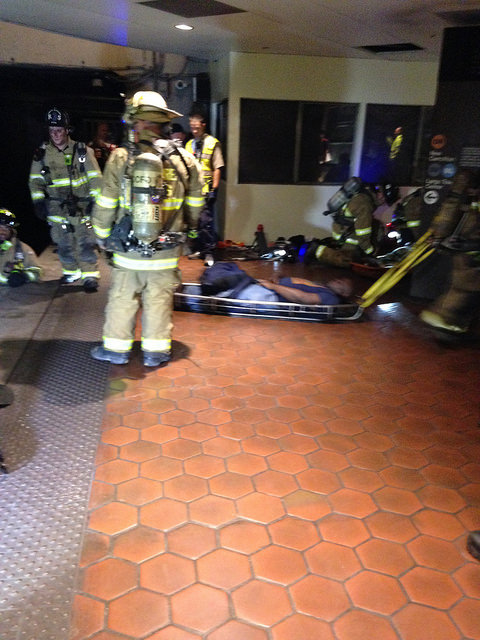
WMATA: Safety Hazards and Security Risks
Last Sunday, the Washington Metropolitan Area Transportation Authority hosted a safety exercise at the Stadium Armory metro stop. For three hours, firefighters and WMATA officials tested their communication and evacuation protocols. Shocking gaps were exposed and I left the event with little confidence in WMATA’s ability to fix them.
I’m the Advisory Neighborhood Commissioner for residents living next to the Stadium Armory stop and I was invited to participate in the exercise because of my ANC position. My participation that day was limited to standing around and taking pictures. I had asked WMATA to include neighbors in the exercise but my request was denied.
After WMATA denied my request, I reminded them of the sarin attack in Tokyo 20 years ago and the more recent attacks in London and Madrid. In a real world attack happens at Stadium Armory, how is WMATA going to communicate with neighbors? No response.
Instead, WMATA hosted a controlled safety exercise and this exercise demonstrated how WMATA staff fail even in a controlled environment. One of the participants in the Sunday exercise was in a wheel chair. Her wheel chair was too large to fit through the doors that are located between each car. WMATA’s solution was to put her in a smaller wheel chair. Slight problem. The lady couldn’t fit in the smaller wheel chair. WMATA’s solution was to put the lady and her large wheelchair in the front car. That made it easier for the firefighters to reach her and carry her out. Read More
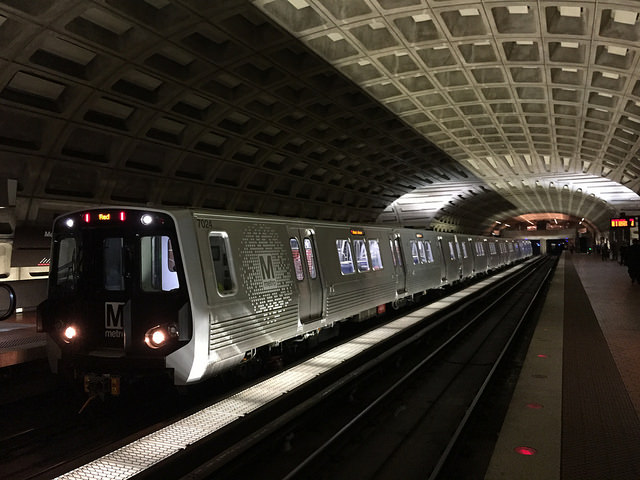
Photo by PoPville flickr user Ken Yu
From WMATA:
“Metro’s fourth new 7000-series trainset will enter service Monday, August 17, on the Green Line.
Departing Greenbelt Station at 5:30 a.m. and Branch Avenue Station at 6:25 a.m., the new train will continue in service throughout morning rush hour and will be assigned to the Green Line.”
and
“Reconstruction of the Metrorail system will continue over the weekend of August 21-23 with service adjustments on five rail lines beginning at 10 p.m. Friday and continuing through system closing on Sunday.
This weekend, Yellow Line trains will operate at regular weekend intervals. Green Line trains will operate every 15 minutes and Red Line trains will operate every 20 minutes.
From 12:01 a.m. Saturday through closing Sunday, buses replace Orange Line trains between Eastern Market & Cheverly and Silver & Blue line trains between Eastern Market & Benning Road. Potomac Ave, Stadium-Armory, Minnesota Ave and Deanwood stations will be closed. Trains outside the work area will operate every 15-16 minutes.”
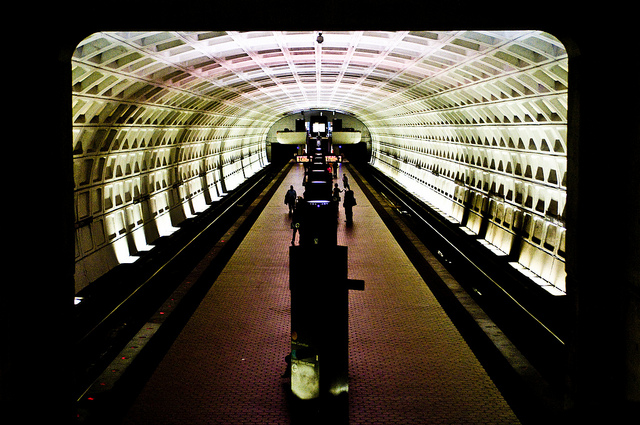
Photo by PoPville flickr user Brian Mosley
From WMATA:
“Metro Transit Police and the District of Columbia Fire and Emergency Medical Services Department will conduct a full-scale emergency response drill at Stadium-Armory Station on Sunday, August 23, from 7:45 a.m. until approximately 10 a.m.
During the exercise, emergency responders will simulate a smoke/fire incident in the tunnel outside of Stadium Armory. Metropolitan Police Department and DC Homeland Security and Emergency Management Agency also will participate in the exercise.
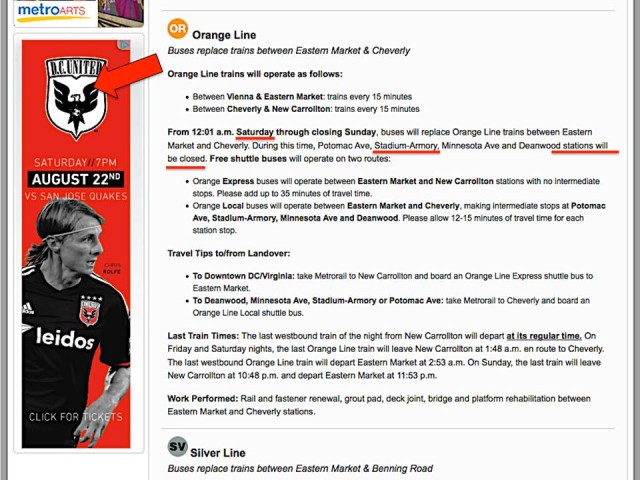
On Facebook, Arnaud Carpentier notes the “Sweet Metro Irony…” in the screenshot above from Metro’s website – due to the scheduling conflict with a DC United match at RFK.
Information for Riders Read More
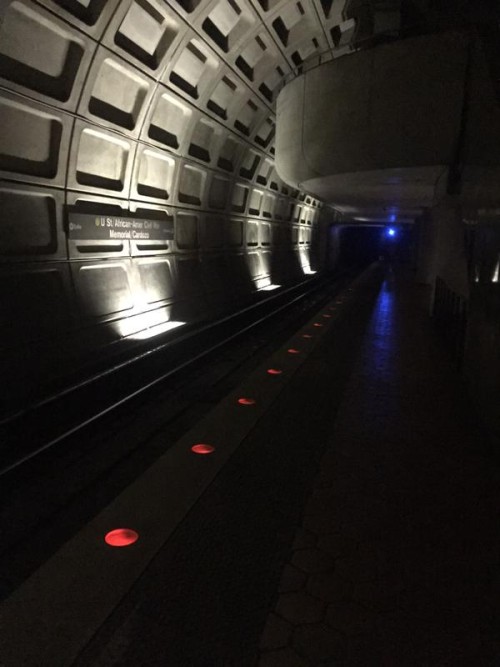
@aadragna tweets us around 9:45am:
“Eerie partial loss of station power at U St. Trains still running.”
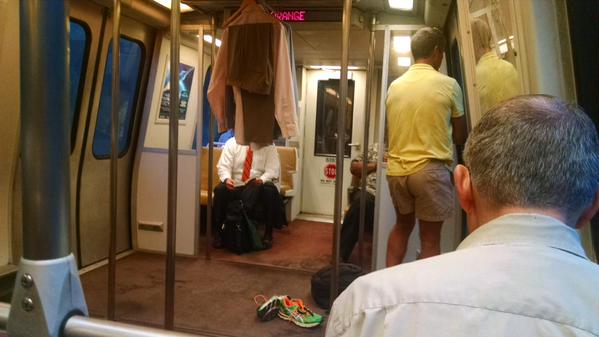
@ctaegel tweets us earlier:
“New closet service offered by #wmata?”
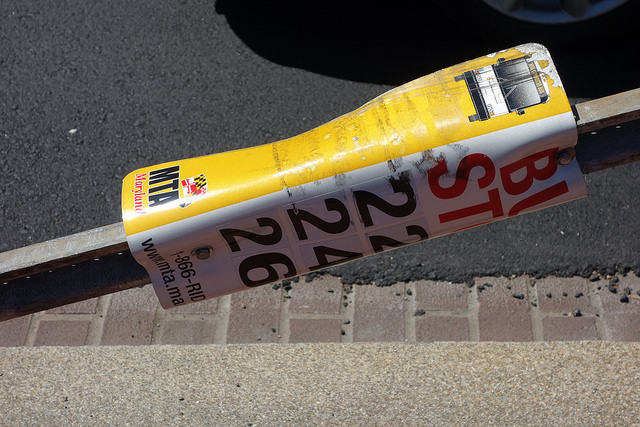
Photo by PoPville flickr user nevermindtheend
From WMATA:
“Reconstruction of the Metrorail system will continue over the weekend of August 14-16 with service adjustments on four rail lines beginning at 10 p.m. Friday and continuing through system closing on Sunday.
This weekend, Yellow and Green line trains will operate at regular weekend intervals. Orange, Silver and Blue line trains will operate every 20 minutes and Red Line trains will operate every 12-24 minutes with additional trains between Farragut North and Rhode Island Ave between 9 a.m. and 9 p.m.”

Photo by PoPville flickr user Eric P.
DataLensDC was started in the summer of 2015 by Kate Rabinowitz, lover of all things data and District. She lives in a cozy Capitol Hill carriage house where she enjoys data mining, board games and wandering the city. Kate created to DataLensDC to present data-driven views of the character, trends and hacks of the ever-changing District.
The Pain is Real: Your Metro Commute is Getting Worse
Last Thursday Metro sent a subtle signal that maybe I should take a day off. Unfortunately my boss felt otherwise. What started as a ‘minor’ derailment became two days of Metro competing with walking for the slowest way to get anywhere. It was bad and feels like part of a larger decline in Metro service. I was curious if that actually bore out in the data. Not only did it, but the decline is even more dramatic than I would’ve guessed.
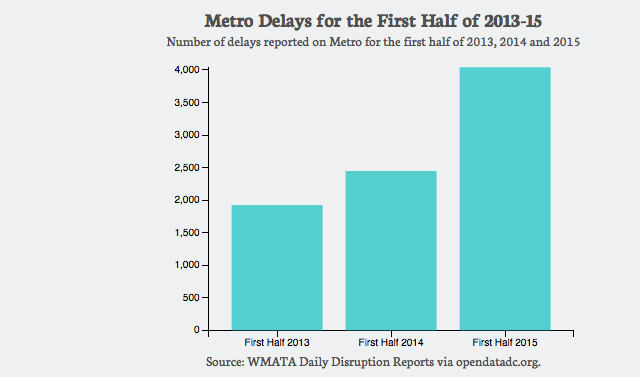
The first half of 2015 had nearly twice as many delays compared to the same period in the past two years. Year to date Metro delays total over eighteen days. This is two and a half weeks. You could spend all your vacation days waiting for the Metro and still be waiting. This increase is partly due to a spike in delays this winter, but the spring and summer saw worse service as well.
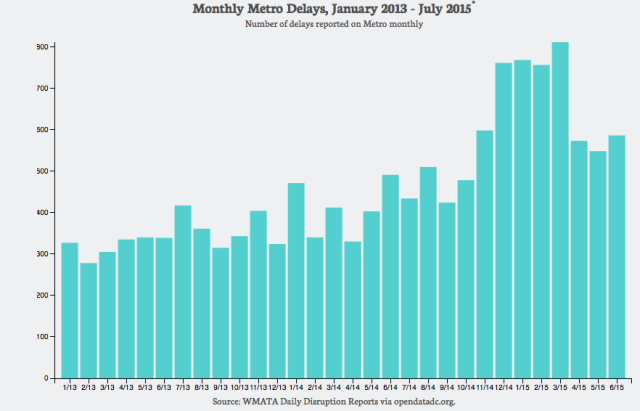
It’d be nice if all these delays happened in the early hours of Sunday morning, since so many have long given up on taking the Metro anywhere on weekends. But the Metro is most likely to be delayed when you need it most. The heatmap below shows that delays are heavily concentrated just before and during commuting hours. Of course WMATA *tries* to run twice as many trains during rush hour. But there are more delays per train during that hour as well. Afterall, the benefit of more trains is debatable when you wait ten minutes for three trains to arrive at once.
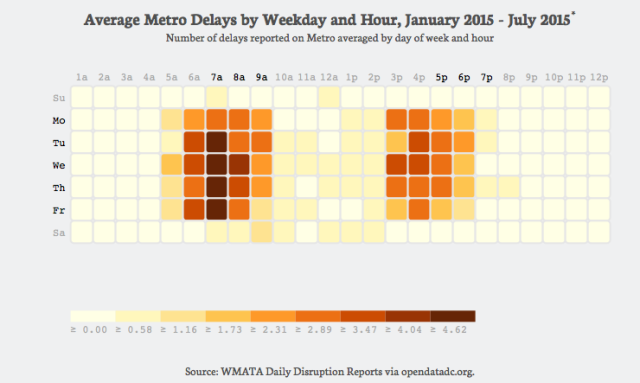
I’m not sure how Metro will improve with all the money it doesn’t have, but on the upside there are only more delays, not longer delays. And on an (un)related note DC keeps expanding bike lanes…
Technical notes: Graphics are based on WMATA Disruption reports. Code for DC has wonderfully scraped these reports in easy-to-analyze CSV files at opendatadc.org. You can find complete code for this post on my github page.
*Data for July 2015 only goes to July 24th. So the numbers are likely even worse!

Photo by PoPville flickr user John Sonderman
From WMATA: “The following statement was issued today by Metro’s Board of Directors:
“The Board is outraged and dismayed that anyone working at Metro would have critical safety information and not act on it immediately. It is totally unacceptable that the wide gauge track problem reported yesterday by the General Manager could go unaddressed and unrepaired for four weeks. This is a breakdown of the organization’s chain of command and our safety culture. We obviously have much work ahead of us to improve the organization’s safety culture, and we will do so,” said Metro Safety Committee Chair Michael Goldman, speaking on behalf of the Board. “However, Jack Requa’s transparent release of information, as well as his actions to order immediate track inspections and gather information to hold people accountable at every level, is what the Board expects and what the circumstances demand.
“The Board has directed the General Manager to complete his operational investigation within 10 days that will explain to the Board and our riders how this track deficiency went unrepaired for so long. The Board looks forward to learning how the chain of command broke down and where the responsibility lies. This is an unforgivable breach of safety that needs to be dealt with firmly and swiftly.”
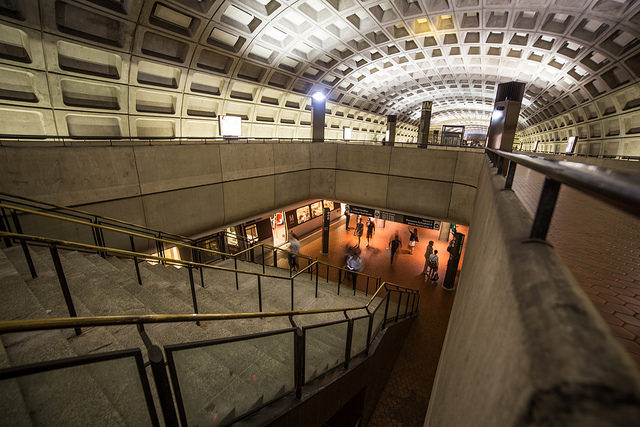
Photo by PoPville flickr user Beau Finley
From Fox 5:
“The derailment of a non-passenger train outside the Smithsonian Metro station last Thursday was caused by a track defect that was discovered on July 9 but not fixed, Metro said.
Following the derailment, Requa ordered a system-wide inspection of every mile of track, which could take up to a month to complete. He said customers can expect delays in the coming days as possible additional track repairs are made.”

